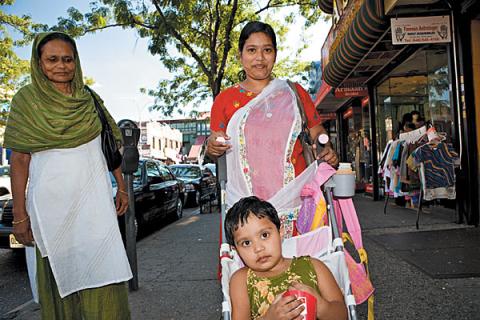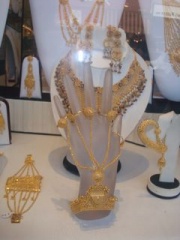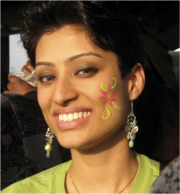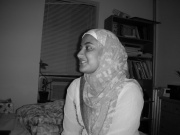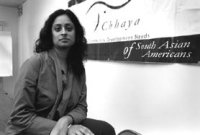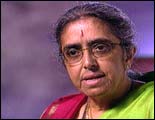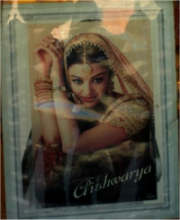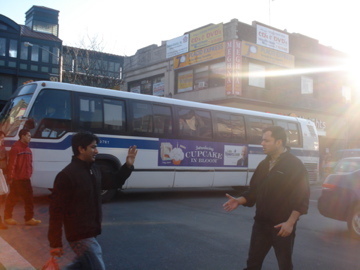From The Peopling of New York City

Contents |
Jackson Heights: Microcosm of South Asian Women's Role in New York?
In Madhulika Khandelwal's reflection on Jackson Heights in Becoming American, Being Indian, Jackson Height's is portrayed as a "little India," commonly adopting an ethnic spelling: “Jai Kishan” Heights. Jackson Heights, with its endless sari shops, 14-Karat Jewelry stores, and South Asian restaurants, is said to be “reminiscent of South Hall in London or a shopping bazaar in India” (Khandewal 2002:26). However, when it comes down to the role played by South Asian women in American society, this little ethnic community fails to fully represent the various changes and growth that women have experience in New York. Jackson Heights is a business center that often portrays women through dress, jewelry, and Bollywood posters. These forms of portrayal tend to fantasize and stereotype South Asian females, depicting them in materialistic, delicate, and homemakers. Even the women who roam the streets are largely housewives. They come with their families to pick up ethnic grocery products, or eat a meal. It is true that many women have held strong to more traditional female roles, as mothers and wives in a more patriarchal family. Furthermore, the depiction of South Asian fashion may also be seen as a representation of the female's culture, and it is definitely a way for a South Asian women to identify herself assertively. However, by simply looking at Jackson Heights, its shops, workers, and visitors, one fails to really understand the growth experienced by South Asian women in New York in the public and professional realms. The professional population of Jackson Heights, its doctor's and immigration lawyers, are all male. Furthermore, shops are owned largely by males, with females working as cashiers or sales clerks. Additionally, circulating local newspapers and letters often showcase parent's efforts to marry off their young daughters. These values still exist amongst the South Asian community, therefore, it is important to use Jackson Heights as a foundation to explore South Asian women in America, for it offers some rich and interesting culture that can start to clarify how women perceive themselves and are perceived by others in New York.
Today, being just a house wife is considered "old fashion." Economic and ideological pressures stress women to go into the workforce. Commonly, when migrating to America, a woman may need a job to help the economical status of the family. Additionally, in Indian and Pakistani immigrant culture, money is stressed and success usually means money, and of course family and health. Other women are driven through loneliness, while some wish to assert themselves as women and "follow their dreams" (Lessinger 1995:110-112).
Dress and Jewelry Defining South Asian Women
Ideals of feminine beauty and marriage (via young eligible brides) are displayed on every street. The ethnic clothing, glittered and made of bright synthetic fabrics, is quite traditional; however, is embraced by contemporary South Asian women and second generation women as well. Commonly, when South Asians gather on holidays, weddings, family/friend events, or even at school's multicultural assemblies, this dress is worn by women of all ages. Some educated woman will sometimes wear their Sari's to work once in a while. Ms. Subramaniam, a chemistry teacher and HIV/AID Researcher, is usually dressed in professional clothing (business suits, pants, dress shirts) but comes he school workplace sometimes with a rich, red sari, a bindi on her forehead, and gold bangles on her wrists to embrace her culture. Besides teaching chemistry, she runs the school's Desi Club.
Women especially are proud to wear their lavish South Asian culture and are great participant in cultural events in New York. Overall, it seems that women uphold ethnic traditions, in religion and custom, more then men do. It is quite rare to see a man dressed in a traditional Indian tunic on the streets of Jackson Heights. Furthermore, women uphold aspects of culture through food, dance and prayer. At The Ganesha Temple in Flushing, Queens, I watched an elderly woman in a ginger sari, eyes overflowing with emotion and love, spin slowly three times, bow to the god, and then walk around the shrine. However, contrastingly, a pair of Indian men dressed in leather jackets and slacks walked in briefly, performed a hand gesture, and left after five minutes. This of course is a generalization, since there are many devout men at the temple. However, proportionally, more women appeared at the temple. (The Ganesha Temple in Flushing) I believe woman uphold their "South Asian-ness," especially via dress and jewelry on ritual occasion, to perhaps better assert themselves and represent themselves. Women, who were less represented in the work force in the past, have had to embrace in culture and ritual to occupy and enrich their lives. These traditions have crossed over and remained as an integral part of the lives of woman. Woman have been able to develop their traditions more substantially because of their important traditional roles as homemakers and nurturer that have stayed with them.
Clarifying the Diverse Roles of South Asian Women: Opinions of South Asian Women
It is unfortunate that when one thinks of women of South Asian descent, they automatically assume that they have just two roles in life: mother and wife. What one has to realize is that this backwards facing ideal does occur but does not apply to the majority of situations. The South Asian women working in Jackson Heights contribute to this progression. They may come here with their husbands, fathers, or male guardians but if they are young and capable of working they have many opportunities to do so and are sometimes even encouraged to.'
Once they move to America, women who may not have worked before now face the pressure to get jobs and help support the family. They sometimes face problems doing so as they are unskilled. In an Interview with Kanushree Jain, 19, said that "when [her] mom was growing up she thought her domain would be housewife so she learned embroidery and amazing cooking and she never really thought about a career." Coming here changes many things for women as they have to come out of their comfort zone and do something that was looked down upon in their home country. Many women don't receive criticisms from their husbands when they want to work, however. In fact, many fathers want their daughters to excel and send them to universities because "education leads to respect...for the family and that's a very important thing."
Sibha Zaheer, 19, is one such example of a young Pakistani woman who is coming out of her traditional lifestyle. Sibgha Zaheer is a young Muslim woman in college, with goals of studying medicine. Currently, she is at a competitive program at The Sophie Davis School of Biomedical Education in City College (CUNY). She was born in Pakistan, but moved to Staten Island, New York before at the age of one. Sibgha connects strongly with her Muslim identity and it empowers her as a woman to take advantage of many opportunities that she would not have in Pakistan. She serves as a foil to her mother, who was raised more traditionally in Pakistan, where her mother’s freedoms of education and socialization with men was restricted. Although Sibgha and her mother tend to butt heads once in a while, modern American culture has become more accepted and more integrated into Sibgha’s life, with the slow approval of her parents. Sibgha's driving force remains her religion, and although she may have conflicts accepting aspects of married life, she lives with big goals for herself.
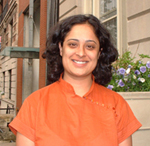
In an Interview with Sibha Zaheer, Sibgha communicates her dual roles and the difficulty balancing her mother's expectations, "I guess as far as the future, my mother expects me to finish school, get married, buy a house, etc. but in everyday life she expects me to be able to balance school work and house work, chores etc. and the chores are often the ones to prepare me for the future/marriage, like cooking cleaning, etc. I guess to her even if a woman gets a job, she still has to maintain all her responsibilities at home. I guess you can say that’s where most of the conflict lies because yes it’s important to be able to balance everything in life and yes preparing for responsibilities later in life is important, but for me personally I only can focus on school or home. It gets very hard to balance chores with school work all the time. But, she has become more understanding about it and has realized that women don’t exactly have that same role anymore."
Education does lead to respect and consequentially, to more opportunities for advancement. Seema Agnani is the Executive Director of Chhaya Community Development Corporation which is an organization based in Jackson Heights that helps South Asian residents with issues regarding home ownership and possible scams. Interviewed by Steve Dubb in June 2007, Agnani discussed the role of women in the business of Jackson Heights. She said that "there are gender politics that play into this [business] as well. A lot of our staff consists of women, while a lot of the business community is male and conservative. It’s not easy, but we are building trust and some business leaders are more progressive than others." This progressive outlook is exactly something that a South Asian woman who achieved a Master's in Urban Planning and Public Policy from the University of Illinois at Chicago would attain from her experiences.
Working Women
South Asian women in Jackson Heights occupy a variety of positions. From sari shops clerks to founders of organizations vital to the smooth running of the neighborhood, women are an integral part of the job market in the area.
Seema Mohan AgnaniSeema Agnani is currently the co-founder and Executive Director of Chhaya Community Development Corporation. Stationed in Jackson Heights, it is an organization that helps South Asian residents figure out home-owning problems and avoid fraudulence. She is a former recipient of The Charles H. Revson Fellowship at Columbia University, earned her Bachelors at the University of Wisconsin at Madison and a Masters of Urban Planning and Public Administration at the University of Illinois in Chicago. Before working in Chhaya, she was the Coordinating Consultant to the Fund for New Citizens at The New York Community Trust, a donor collaborative supporting immigrant rights work. She was also the Director of Training and Technical Assistance at Citizens for NYC. In addition, she worked with Asian Americans for Equality for several years as a housing development associate while also focusing on fundraising and development; and later served as a coordinator of the Lower Manhattan Health Care Coalition.
Doctor Uma Mysorekar
Dr. Uma Mysorekar was born and raised in Bangalore, Karnataka State, India. After studying medicine at the University of Bombay and being awarded the gold medal for academic excellence, she came to the United States and began practicing gynecology and obstetrics in New York City in 1970. Her accomplishments include being involved and later becoming president of Heart and Hand for the Handicapped; pioneering fundraising for Aid to the Disabled, Orphaned and Poor (ADOP) under the auspices of the Hindu Temple Society of North America; contributing toward the construction of a hostel for poor working women in Bangalore, India. She is the current president of the Hindu Temple Society of North America. As the head of the society, Dr. Mysorekar has initiated programs to bring the community together, including spiritual, educational, and cultural activities. To further bring the community together, she initiated interfaith meetings and has spoken at numerous functions to increase public understanding of Hinduism. She has received several awards over the years for her contributions and community service.
Aishwarya Rai
Aishwarya Rai, born in Mangalore, the chief port city of the Indian state of Karnataka, attended Ruparel College in Matunga in pursuit of studying architecture. When she won the Miss World Pageant in 1994, she gave up architecture and took up modeling and later on, acting. Once she achieved fame, she started participating in fundraising events such as the HELP! Telethon Concert to help raise money for the victims of the 2004 tsunami earthquake. In 2005, she became the ambassador for Pulse Polio, a campaign started by the Government of India in order to stop Polio in India. Along with her family she laid the foundation for a school for underprivileged girls in the Daulatpur village in Uttar Pradesh. She can communicate in Tulu, Hindi, English, Marathi and Tamil. Her beauty and talent influences South Asian girls living in Jackson Heights today. Advertisements of her wearing different kinds of jewelry adorn jewelery shops and movie posters featuring her in various Bollywood movies are prominent in video stores. She is an integral part of the South Asian community in America as she is someone many girls strive to be in power, beauty and skills.
South Asian Men Respond to Female Employment
Walking through Jackson Heights, one notices the social differences established between males and females. Whether it is as obvious as a woman walking a few paces behind her husband or as subtle as three women working the register at a sari shop under a male manager, the differences between gender exist in the business district. Walking down 37th Avenue, one will see women at the register at many business, including Sona Music, Nanking Restaurant and Akabir's Bakery. 37th Avenue Often, these women speak English poorly, many having recently immigrated to America. Although many woman work menial jobs, a few male shop owners have communicated the important of the working woman. In an Interview with Sunita petimar, Sunita, the male show owner “Shri Krishna Jewelers” on 74th Street says, “Nowadays in India, women have to work, just like they do in America. It used to be that women did not leave the home; they just cooked and cleaned, and so on. But now India is developing, especially in big cities like Bombay, and women have to work just like in America. My wife was always used to working.” Sunita’s daughter is currently going into Pharmacy and he encourages education and job choice freedom greatly, “We let them do whatever they desired. They could have gone into any field they wanted.” However, I do not think the fact that Sunita’s daughter has gone into pharmacy (another health-related field) and his son, into engineering, is a coincidence with the trend among many South Asians. These decisions were most likely influenced by the parents of the household. Regardless, family trends a pointing to equalizing South Asian men and women, especially in the second generation.
Sunita’s opinion, to equalize men with women, is becoming more common in South Asian families. What one might not realize is how gender discrepancies are changing, outside of the Jackson Heights model. Some dynamics still stand strong. Kanushree Jain, like many other South Asian women, followed her father in coming to America. Her father was suffering business losses and came here with his brother. Later on, Kanushree, her siblings, and her mother came here when he found work and an apartment in Flushing, Queens. Some women are not lucky enough to find husbands or fathers whom they could follow to the United States. “A highly-placed woman executive in South India, unmarried at 55, confessed with a grin that she had to have a guardian when she was transferred to an Indian city in which she had no relatives” (Lessinger 1995:110).
That being said, most men do not want their wives and daughters to be lacking in education. “My father wants me and my sister to get an education and rise up in the world,” says Kanushree Jain in Interview with Kanushree Jain. Many men, "particularly, the more sophisticated and professional, encourage their wives, become proud of their wives' careers and successes and even offer some help with housework and child care" (112). These men want their wives to be educated and to have a job because the wives become "far more interesting companions and [occupy] a more equal role in the family now that they [have] jobs" (112). This success through education does not differ from that of Suleman Ilyas' father in The Male Perspective: Suleman Ilyas. When asked about whether his sister would be expected to settle down and have children after she was married, Suleman replied: "No, my father would still have sent her to school. She may have been a doctor there. My dad really values education and she would go to school." Jeffin Mathew, in Interview with Jeffin Mathew, underscored this opinion once more when he said that, "More than anything, [my parents] want a complete education for us. That’s what most Indians want for their kids. They don’t care what we study, as long as we complete it and make something of ourselves."
Unfortunately for South Asian women, not all men are as progressive as the ones mentioned above. Some men allow their wives to work because the money they would bring to the table is very necessary, especially for new immigrants. However, as soon as the husband notices that the wife brings up certain ideas about feminism or equality that she gathered from conversation with other women, he might get very angry and force her to quit her job. A wife having a temporary job until the husband finds a steady form of income does not have to be a bad thing, however. Kanushree Jain said this of her mother's employment: "The mother would work if she had skills and she needed to but she doesn’t have to work if the father makes enough to support the family." It is a plain statement, without any sense of bitterness or scorn behind it. Suleman Ilyas, whose mother is in a similar situation to Kanushree's, even jokingly refers to his mother's occupation as "domestic engineer- housewife.” It is not something that is looked down upon, it is a fact of family life and it is a most necessary contribution to the family.
This page was done by Aleksandra Polonetskaya and Shanna Kofman.
